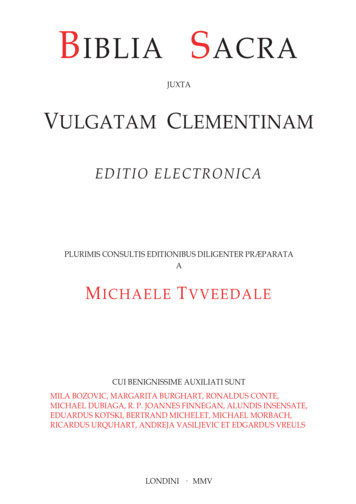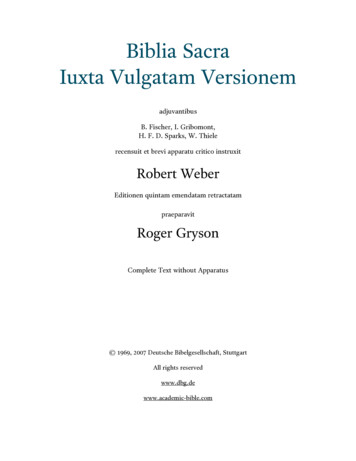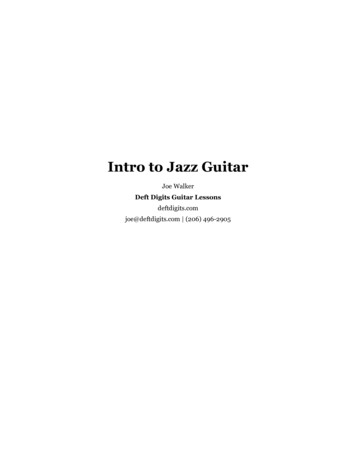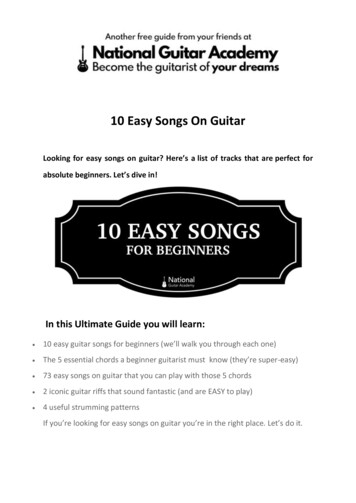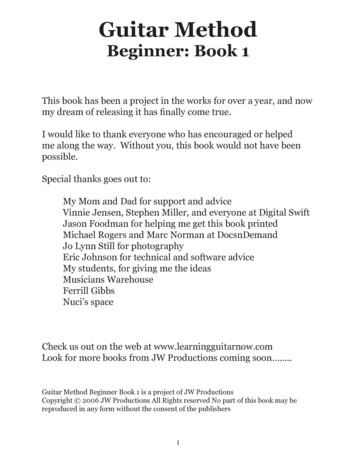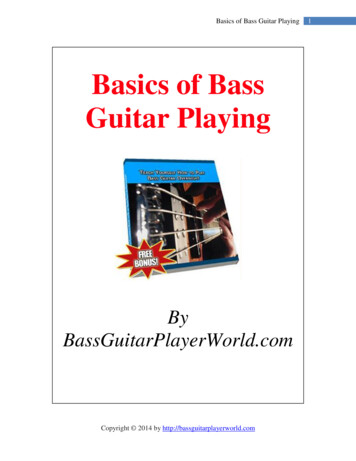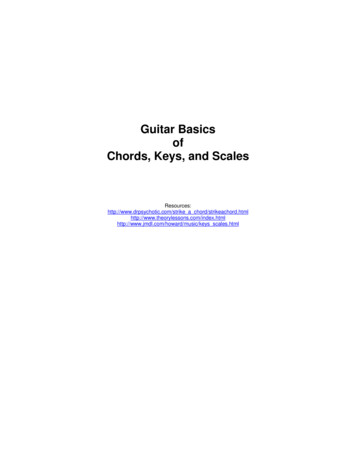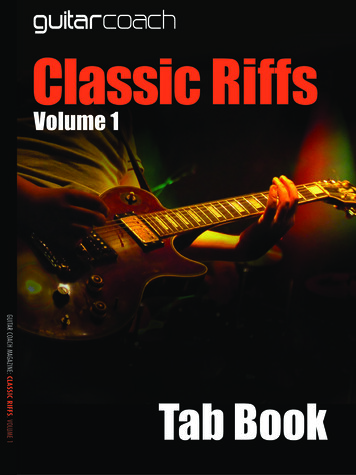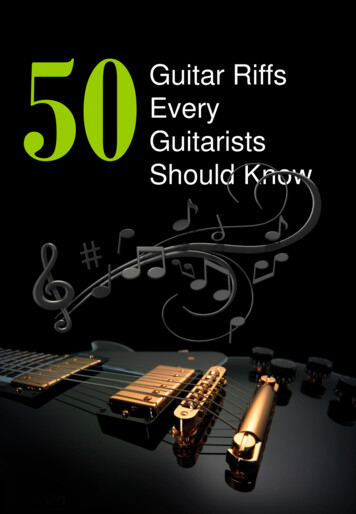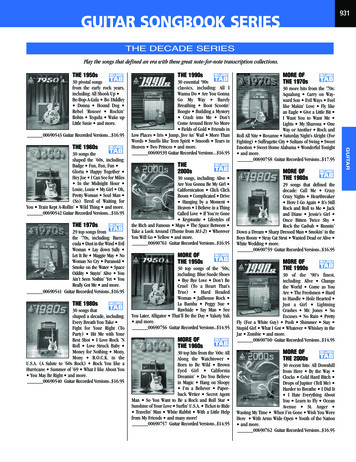
Transcription
Guitar Basicsblankfirst edition, revised 2004 Brian Newman All Rights ReservedThis is the FREE pdf version. You may print and use this book for yourpersonal use only. This book may NOT be duplicated without the permissionof the copyright holder. If you wish to make copies, please contact the author:(503) 799-7974 or email: brian@briannewmanmusic.com
PrefaceThe BasicsPeople learn to play guitar for different reasons, from self-amusement, theamusement of friends, to making a career of it. To a large degree, the goaldetermines the course of study. Someone who wants to strum in front of aGuitar Basicscopyright 2004 Brian Newman All rights reservedBasicscampfire will want to learn some basic chords and rhythms; someone whowants to play in a band will need to learn bar chords and scales.I’ve gathered these concepts and present them in this book to serve as alaunch pad for further study, for whatever goal you may have. This book ismeant as a text for private and group lessons. The main concepts coveredare note reading, chording, fingerpicking and major scales. These basicskills are rudimentary for any style of playing.After completing this book, you should have solid basic skills and a cleareridea as to what style or styles to pursue.The best way to go about learning any instrument is to find a good teacherand develop a consistent practice routine. While this book is not meant tobe a substitute for a good instructor, it is meant to get your feet wet in therealm of musicianship. It is my goal to present these basic concepts in away that encourages the student to learn more.
Blank
Parts of the GuitarTuning KeysNutFretsNeckBasicsFretboardSelector switchSound holePick-guardPickupsBridgeBodyVolume and ToneGuitar Basicscopyright 2004 Brian Newman All rights reserved
TuningRelative TuningAssuming that the 6th string is in tune, pressing the 6th stringon the 5th fret produces the pitch A, which is the same pitch asthe next open string, string 5.Pressing the 5th string at the 5th fret produces the pitch D, thesame pitch as the next open string, string 4.The 4th string at the 5th fret produces G,the 3rd string at the 4thfret produces B and the 2nd string at the 5th fret produces E.BBasicsTuning to a PianoVA D GEThe notes of the piano corresponding to the guitar:6 5 4 3 2 1E A D G B EEADGBE6th5th4th3rd2nd1stMiddle CUsing an Electronic TunerElectronic tuners have a small mic forpick up, or may be plugged into.0MIC-50 50INOUTGuitar Basicscopyright 2004 Brian Newman All rights reserved
Hands23m1ia4pBasicsOpen StringsNeck Diagram:nutNotation:E A D G B E6 5 4 3 2 1E, 1stfretsww4& 4 wwwwB, 2ndG, 3rdD, 4thA, 5thstringsE, 6thGuitar Basicscopyright 2004 Brian Newman All rights reserved
PositioningBasicsSittingSit comfortably in a chair that allows both feet to rest flat on the floor. (Depending on yoursize and the size of the chair, you may want to elevate your right leg, by using a footstoolor stack of books). The guitar should sit on your right leg with your right arm resting on topof the body of the guitar keeping the neck tilted slightly upwards. Do not support the neckwith your left hand, rather keep the guitar in position with your right arm. Your left handneeds to be free to move about the fretboard. The bottom side of the guitar should rest flaton your leg; not at an angle. Your right forearm should be loose and free, ready to strum.FrettingTo effectively play a note on a string, press your fingertip directly behind the fret,perpendicular to the fretboard. Placing your finger on top of the fret will result in a“muted” sound, placing it too far behind will cause “buzzing”. Touching adjacent stringscan result in either. It is essential, especially when chording, to keep your fingers fromtouching adjacent strings. Practice playing individual notes before trying whole chords.Guitar Basicscopyright 2004 Brian Newman All rights reserved
PositioningFlatpickingHold the pick between your thumb and index finger, with your index finger slightlybent. When strumming, hold the pick lightly, allowing it to glide across the strings.Hold it tighter for plucking single notes.Down strum:Up strum:Guitar Basicscopyright 2004 Brian Newman All rights reservedBasicsStrummingStrumming should be a fluid motion involving your right forearm, wrist, and pick.Let the pick glide across the strings at an angle; note that the tighter you hold the pick,the more it has to flex of its own, resulting in a “bright” tone. Tone can be varied byyour grip on the pick, how you attack the strings and by different shapes and thicknessesof the pick. Buy an assortment and experiment.
How to practice“Remember the direct correlation betweentime spent in practice and ability to play.”Practice is essential to any creative discipline. To make steady progresswith your instrument, consistent, deliberate, regular practice is necessary.The following are some suggestions for maintaining a healthy practice routine:1) Designate a regular time and place to practice –Basicspreferably away from other distractions such as the television or stereo orany other background noise.2) Have a goal –It may be a new scale, exercise, or the first few bars of a new song.Start with a warm-up exercise, then play something familiar. After you’veloosened up to play, begin working toward your goal.3) Reward yourself –Don’t practice for too long without a break. If you begin havingtrouble concentrating, take a few minutes to stretch and get a drink.4) Don’t give up –Skills take time and effort to develop. Practice may seem tedious at times,but diligent, steady progress is the only way to develop solid musicianship.Sample practiceWarm-upFamiliar songLesson5 min.5 min.20 min.Guitar Basicscopyright 2004 Brian Newman All rights reserved
Practice RecordWhat to Practice:Date:When You practiced:startEndSunMonTuesWedsThursFriSatWhat to Practice:Date:When You ate:What to Practice:When You practiced:startEndSunMonTuesWedsThursFriSatWhat to Practice:Date:When You practiced:startSunMonTuesWedsThursFriSatGuitar Basicscopyright 2004 Brian Newman All rights reservedEnd
Practice RecordWhat to Practice:Date:When You practiced:startEndSunMonTuesWedsThursFriSatWhat to Practice:Date:When You ate:What to Practice:When You practiced:startEndSunMonTuesWedsThursFriSatWhat to Practice:Date:When You practiced:startSunMonTuesWedsThursFriSatGuitar Basicscopyright 2004 Brian Newman All rights reservedEnd
Practice RecordWhat to Practice:Date:When You practiced:startEndSunMonTuesWedsThursFriSatWhat to Practice:Date:When You ate:What to Practice:When You practiced:startEndSunMonTuesWedsThursFriSatWhat to Practice:Date:When You practiced:startSunMonTuesWedsThursFriSatGuitar Basicscopyright 2004 Brian Newman All rights reservedEnd
NotationNotes convey pitch and rhythm. Notes are held on a staff. A note towards the topof the staff is higher in pitch than one towards the bottom of the staff. Bar lines separatemeasures, measuring time or rhythm. The time signature tells how much time, or howmany beats are contained in a measure. Most music has 4 beats per measure, with thequarter note equal to 1 beat.PitchBasicsTreble or “G” clef&StavesThe treble clef circles the note GThe notes on the spaces can beremembered by what they spell:F,A,C,Ew&w w wFA CEThe notes on the lines can beremembered by acronyms:Every Good Boy Does Fine orEmpty Garbage Before Dad Flipswww&w wEGuitar Basicscopyright 2004 Brian Newman All rights reservedGBDF
NotationRhythmTime signatures& 4443The top number gives beats per measure, thebottom number gives the note value of the beat.Four-four time is four quarter notes. Three -fourtime is three quarter notes. Six-eight time is sixeighth notes, and so on.68BasicsBar lines&Measuresw Whole note 4 beatsh Half note 2 beatsq Quarter note 1 beat„ Whole restÓ Half restŒ Quarter restGuitar Basicscopyright 2004 Brian Newman All rights reserved
Rhythms #1w Whole note 4 beatsh Half note 2 beatsq Quarter note 1 beat„ Whole restÓ Half restŒ Quarter restFor this rhythm exercise, pluck an open string and let it sustain for the duration of the note valuewhile you count “one, two, three, four” out loud.&c wBasicscount: 125& œ9& &Œ3œ œ14 2w 3œ œ œ4œœœ1234œŒœœÓœGuitar Basicscopyright 2004 Brian Newman All rights reservedœŒœ1234 œÓ œœœ œœœŒœœ
Notes of the First StringThe open first string sounds the note E, shown here in a fretboard diagram and as notation. The firstfinger on the first fret is F, the third finger on the third fret is G.&w&w&G1st string exercise:4 &45&9& œœœœœ œœ œœœœœœ œGuitar Basicscopyright 2004 Brian Newman All rights reservedwœœwœœwBasicsFEw
Notes of the Second StringThe open second string sounds the note B, the first finger on the first fret is C, the third finger on thethird fret is D.&wBasics&wB&CwD2nd string exercise:& 44 5&œ9& œ œœœœœœœœœ œœ œwœœwœœwGuitar Basicscopyright 2004 Brian Newman All rights reserved
Having learned some first position notes, the following are some melodies on which to try them.Keep your eyes on the music, use proper finger positioning, and say the note names out loud; thiswill help you learn them.Melodies14œ œ œ œ&4œ œ œ œœœ œ œœ4œ œ œ œ&4œœ œ œ œœ2œ œ œœ œ BasicsOde To Joyœ œ œ œc&0&œœœ œ œ œ31œœ œ œ œœBeethovenœœ œœ 1œœœœœœGuitar Basicscopyright 2004 Brian Newman All rights reservedœœ
Notes of the Third StringThe open third string sounds the note G, the second finger on the second fret is A.&w&wGABasics3rd string exercise:A 44 NNNNNNNNNNNNLExercise on first three stringsN N N N4A4ANNNNANMNNNNMNNN N MN N N NN N N NNNNNGuitar Basicscopyright 2004 Brian Newman All rights reservedNNNNLNL.
Twinkle TwinkleBasicsKing WenceslasEnglish TraditionalGuitar Basicscopyright 2004 Brian Newman All rights reserved
Notes of the Fourth StringThe open fourth string sounds the note D, the second finger on the second fret is E, the third fingeron the third fret is F.Basics&w&w&wDEFNotes on the 4th string:&c w5&œœœœœœœœœœœ œœœœœwœw9& œGuitar Basicscopyright 2004 Brian Newman All rights reserved
Rhythms 2)Introducing the tieand the dotted note qd value, along with the eighth rest (‰).The tie connects two notes within a measure or across a barline. The dot adds half of the notes’value to the note, for instance, a dotted quarter note equals one and a half beats, or three eighth notes(q. q e) A dotted half note equals three quarter notes, etc.Play through each line using an open string.& 44 œ2&œ3& œ.œ œJ4& œ.œ5&‰ œœ œœœœœœ .œ œ œJœ œ œ œJœœœœœœœœœœœ œ.œœ.œœœ œ œœ œ Œœœœ œ œœŒGuitar Basicscopyright 2004 Brian Newman All rights reservedœœ œBasics1
Amazing GraceBasicsJohn NewtonYankee Doodleœ œ œ & 44 œ œ œfingers:13100œ œ œ œœ œ œ œ &03112& 200020 œ œ œ œ361œ œ œ œ 1œ œ œ œ œ œ œ œ œ œ 202œ œ œ œGuitar Basicscopyright 2004 Brian Newman All rights reservedœ œ œ œ0œ œ œ œ0 20 3
Scarborough FairBasicsPharoah MusicGuitar Basicscopyright 2004 Brian Newman All rights reserved
The Fifth StringThe open fifth string sounds the note A, the second finger on the second fret is B, the third fingeron the third fret is C.&wBasics&A&wBwCNotes on the 5th string:&c w5&œœœœœœœ œœœœœœœ œœwœw9& œGuitar Basicscopyright 2004 Brian Newman All rights reserved
BasicsGuitar Basicscopyright 2004 Brian Newman All rights reserved
Basics12 Bar BluesFrere Jacqueintroducing harmony &c œ œ œ œ1000 œ &œ œ œ œ œ0053039& œœ13& œœ1œ œ œ œ œ œ0œ œ 31œœœœœœœœ œœ œœœœœœœœœœœœœœ œœœœ œœœœœ œœœœœœ œœ œ œœœœœœ œœ œœœœGuitar Basicscopyright 2004 Brian Newman All rights reserved
Note and Chord œœœœœœœ 0œ œ2 0œ 0œ œ2 0 œœ 30364œ& œ œ œœœ œ œ œ œœœ œ œ œ œœœ œ œ œ œ 0312& œ œ œ œ œ œ œ œœ œ œ œ BasicsSimple GiftsGuitar Basicscopyright 2004 Brian Newman All rights reserved
BasicsGuitar Basicscopyright 2004 Brian Newman All rights reserved
The Sixth StringThe open sixth string sounds the note E, the first finger on the first fret is F, the third finger on thethird fret is G.&&Blankw&wEwGFNotes on the 6th string:4&4 The Natural Scale:4&4 œ œ œ œ&œ œ œ œ œ œ œ œœ œ œ œ wœ œ œ œœ œ œ œœ œ œ œœ œ œ œw
What’s a Chord?A chord is a group of notes played (strummed or plucked) together. The basic kind of chord isthe major triad. As the name implies, triads are made up of three notes – the root, third and fifthnotes of the scale. The root is the note on which the chord is based. For example, the C chord isbased on the note C. The other notes, (3rd and 5th) are derived by counting up from C (Ccounts as one, D two, E three, etc.).C major scale:Chords&cœœœ1stCœœ3rdœœœ5thGEC Major chord& c ww m3w M3C to E Major 3rdE to G minor 3rdAnother way to think of it is: Root, 3rd, 5th. The root note of the major scale followed by the3rd and 5th notes of the scale.Guitar Basicscopyright 2004 Brian Newman All rights reserved
Chord DiagramsDiagrams show fingering positions for chords and are a great visual way to develop a chordvocabulary. In the chord diagram,”R” means the root note of the chord, or the note the chordis named from, and “X” means don’t strum that particular string.D7X X R123An open chord diagram showing fingering, the root onstring 4 and X’s over strings 5 and 6.RootF11234A bar chord diagram showing fingering and the root.Notice the 1st finger layed across the fretboard coveringstrings 1,2 and 6. When moved up the fretboard, thissame shape becomes different chords.Guitar Basicscopyright 2004 Brian Newman All rights reservedChordsBar chords are moveable chord forms that don’t use open strings; instead, the 1st finger actsas a “bar” , played across the fretboard while the other three fingers fret different notes. Thefingering in the diagram below on the first fret is F, when moved to the second fret, F#, onthe third fret G and so on. These are extremely handy once mastered. Bar chords in thisbook are grouped into types one and two, based on the root of strings five and six.
EmE0 0R0RE70 00 00R11223A2AmX RChords30A7X R0X R0011232D3DmX X R32D7X X RX X R11232123Guitar Basicscopyright 2004 Brian Newman All rights reserved3
GmG00R0G7XR X 000R0112232B334BmX XB7RX X0X R1124322343CX R4C7Cm00RX XX R0112213234Guitar Basicscopyright 2004 Brian Newman All rights reserved34Chords1
FFmX X RF7X X R11X11111223Bm7Em7Chords3300R1Am7X R 0X R00123132424D7susD/FsG/BXX X R00X 0XX1234224Guitar Basicscopyright 2004 Brian Newman All rights reserved34
Strumming ChordsTo begin using chords, you must first learn the fingerings, then practice switching between them.Start with some easier chords (such as the ones in the following exercise) and strum slowly, keeping an even tempo. It is important not to strum at a tempo faster than what allows you to switch tothe next chord. Learn to switch between two chords at a time, say Em and Am, then switch betweenothers until you can play through the whole exercise. After you are comfortable with the firstexercise, move to the next one.Exercise 1ChordsExercise 2Guitar Basicscopyright 2004 Brian Newman All rights reserved
Exercise 1Strum downward on each beat:ChordsExercise 2Pluck only the bass note on the first beat, strum on the second beat; bass note on the third beat andstrum on the fourth beat:Exercise 3Play alternating bass notes on beats one and three; strum beats two and four:Guitar Basicscopyright 2004 Brian Newman All rights reserved
Strum PatternsUse these strum patterns to practice new chords; feel free to combine patterns and create your own.The important thing is to count as you play these and play them in time. Note also the down and upstrum markings.1 &c ’12&234’’’’’’’’&23&4&’ ’ ’’ 4&4 ’ ’’’ ’’ ’ ’ ’ ’ ’ ’ ’’’’’’2&2’&2& 33’43&4 &’ ’ ’ ’ ’ ’1’ ’ ’&’’’’’’4Guitar Basicscopyright 2004 Brian Newman All rights reserved’’’’’’Chords ’’15 ’ ’’ ’ &’14 ’ &’’’’’’’’ ’’’’’’’’ ’’’’’’’’13 ’
More Strum PatternsThree-four time often feels like a waltz; to accentuate that feel play only the root of the chord onbeat one followed by strums on beats two and three. Variations are also shown.Chords 3&4 ’ ’ ’ ’ ’ ’. &’ ’ ’ ’ ’ ’ .’ ’ ’ ’ . &’ ’ ’ ’ ’ ’ ’ ’.Six-eight time is peculiar in that it can feel like two groups of three, or a slow two. Playing justeighth notes makes it feel like threes; accenting beats one and four makes it feel more like a slowtwo. 6&8 ’ ’ ’ ’ ’ ’’ ’ ’ ’ ’ ’ . & ’ ’ ’ ’ ’ ’ ’ ’ ’ ’ ’ ’ ’ ’ ’ ’ ’ ’ ’ ’ . accent accent .& ’ ’ ’ ’ ’ ’ ’ ’ ’ . ’ ’ ’ ’. ’ ’ ’ .Guitar Basicscopyright 2004 Brian Newman All rights reserved
Guitar Basicscopyright 2004 Brian Newman All rights reserved
RootRootBar ChordsEFForm I11The Form I Bar chordhas the same form as the open E chordwith the root on the 6th tABForm II2341132B7The Form II Bar chordhas the same form as the open A chordwith the root on the 5th string4Bm7Bm11111123434Bmaj711223Guitar Basicscopyright 2004 Brian Newman All rights reserved34
Chord Form StudyThese exercises are to get you familiar with the neck. Exercise 1: Beginning with Cmaj7 on the VIIIfret, it is a cycle of fourths all the way down to fret II. Starting again with Bmaj7 on the VII frettakes you back to fret I. Two chords are played in each position, covering all twelve possible chords.After playing through this using major 7 chords, play through it using minor, minor 7, dominant 7,and major chord forms. Exercise 2: This progression is more like you will find in songs. The fretpositions will dictate which chord form to use. Notice that the last two chords are in open position.Exercise 1VIIIIVVICmaj7Fmaj7(form 1)(form 2)B bmaj7E bmaj7A bmaj7IID bmaj7G bmaj7Bmaj7&c ’ ’ ’ ’ ’ ’ ’ ’ ’ ’ ’ ’ ’ ’ ’ ’5Bmaj7VEmaj7Amaj7IIIDmaj7&’ ’ ’ ’ ’ ’ ’ ’Gmaj7ICmaj7’ ’ ’ ’Exercise 2Guitar Basicscopyright 2004 Brian Newman All rights reservedFmaj7B bmaj7’ ’ ’ ’ChordsVII
TabulatureTabulature (or TAB) is a visual way of writing music for guitar and otherstringed instruments. The hoizontal lines represent the strings of the instrument,and the numbers indicate the fret on which it is played. You will most likely seetabulature added underneath standard notation.&cœ œ œ œœ œStrings:1234TAB3056Frets2302
Finger PickingFinger picking is using your right hand fingers to pluck thestrings. Your right hand should be relaxed, resting over thestrings near the back edge of the sound hole, fingers justabove the strings ready to strike. To correctly pluck a stringin free-stroke fashion, engage the string with the tip of yourfinger and let it slide off the end of your nail as you pullyour finger toward the center of your hand. Generally, thethumb plays bass notes and the fingers play some sort ofarpeggio. However, the number of picking patterns isvirtually limitless. Shown here and on the next pages are afew simpler patterns.*Notice the Right Hand finger designationsbelow the notes.œ œ6&8 œ œ œœammiJp iTAB&c00103 œœœœœipTAB103am01i œ0œœœœ03010ipma
Fingerpicking ExercisesFinger PickingIt is helpful to think in terms of chords for your left hand, while the right hand plucks the individualstrings.Guitar Basicscopyright 2004 Brian Newman All rights reserved
Finger PickingGuitar Basicscopyright 2004 Brian Newman All rights reserved
Finger PickingThis exercise shows how the bass note can “walk” down the scale as the chords change.Once you are comfortable with this one, try using the patterns on the bottom of the page.Notice the different rhythmic feel of the different time signatures.BlankGuitar Basicscopyright 2004 Brian Newman All rights reserved
C major scaleA scale is a pattern of intervals played in succession. An interval is the distance between two notepitches, for instance, from C to D is an interval of a whole step; from E to F is a half step(there are no half steps between B and C, and E and F). Two half steps equal one whole step. Themajor scale has an interval pattern of “whole step, whole step, half step, whole step, whole step,whole step, half step”. Or more simply put: wwhwwwh.&cœ œ œ œœ œ œ œwwhwwwœ œ œ œœœœœ.hThe C major scale is illustrated below using notation and tabulature.Scales&c œ œ œ œfingers:TAB33023023œ œ œ œ02020101œ œ œ œ10GuitarGuitar BasicsBasicscopyrightcopyright 20042004 BrianBrian NewmanNewman All rights reserved20œœ œ320œ.3
G major scaleThe G major scale needs the note F raised by a half step in order to conform to the wwhwwwh majorscale pattern. This is shown by a sharp (s) in the key signature, meaning every time you see the noteF, play an F sharp.Key SignatureScales# 4† 4TABœ œ (s) œ œœ œ œ œ03203# œ œ œ œ†20402103102042œ œ œ œ0035œ œ œ œœ (s) œ œ œœ œ œ œ.w.32Guitar Basicscopyright 2004 Brian Newman All rights reserved03232
D major scaleThe D major scale needs the notes F and C raised by a half step in order to conform to thewwhwwwh major scale pattern. This is shown by two sharps (s) in the key signature, meaning everytime you see the notes F or C, play them sharp.## c†TABœ œ œ œœ œ œ œ02040223œ œ œ œ3202œ œ œ œ .0420ScalesD major scale2 octavesTo play the second octave of the D scale, shift to second position as noted (II) and then to the seventh position.## c&I05&##œœœ2042œœ œ œ œIIœ œ œ œœ œ œ œœ0œ2œ3œ0œ1œGuitar Basicscopyright 2004 Brian Newman All rights reserved.2œVIIœœ 1344œœœ
A major scaleIn A major, F,C and G are sharped.†###cScalesTAB0204### œ œ œ œ†52œ œ œ œœ œ œ œ03221402102œ œ œ œ4œ œ œ œœ œ œ œ2032.œ œ œ œ . w20Guitar Basicscopyright 2004 Brian Newman All rights reserved.420454
E major scaleGuitar Basicscopyright 2004 Brian Newman All rights reservedScalesF major scale
C major scaleScalesin 2nd positionG major scalein 2nd positionGuitar Basicscopyright 2004 Brian Newman All rights reserved
Major Scale Warm-UpThis moveable exercise utilizes all six strings.Note the pattern change on the way down the scale.II Position:#& cGuitarœ œ œ œ œœœœœœœœœœœœœœœœ œ œ œ œTAB325325352325352425452425œœœœœ œ œ œ œ œ œ œœœœœœœœœœœœœœœœ& œœœ œœ4#ScalesTAB425452452453435553 523 52 332535# œœ œ œ œ œ œ œ œ œ&œ œ œ œ œ œ œ œ œ œœ8TAB54252542425353Guitar Basicscopyright 2004 Brian Newman All rights reserved2523II1[5œœœœ 3 .4334553234.
AppendixFeel free to copy the following pages.Blank
Practice RecordWhat to Practice:Date:When You practiced:startEndSunMonTuesWedsThursFriSatWhat to Practice:Date:When You tDate:What to Practice:When You practiced:startEndSunMonTuesWedsThursFriSatWhat to Practice:Date:When You practiced:startSunMonTuesWedsThursFriSatGuitar Basicscopyright 2004 Brian Newman All rights reservedEnd
Practice RecordWhat to Practice:Date:When You practiced:startEndSunMonTuesWedsThursFriSatWhat to Practice:Date:When You tDate:What to Practice:When You practiced:startEndSunMonTuesWedsThursFriSatWhat to Practice:Date:When You practiced:startSunMonTuesWedsThursFriSatGuitar Basicscopyright 2004 Brian Newman All rights reservedEnd
AppendixGuitar Basicscopyright 2004 Brian Newman All rights reserved
AppendixGuitar Basicscopyright 2004 Brian Newman All rights reserved
AppendixGuitar Basicscopyright 2004 Brian Newman All rights reserved
AppendixVGuitar Basicscopyright 2004 Brian Newman All rights reserved
VTABAppendixGuitar Basicscopyright 2004 Brian Newman All rights reserved
AppendixNotesGuitar Basicscopyright 2004 Brian Newman All rights reserved
meant as a text for private and group lessons. The main concepts covered are note reading, chording, fingerpicking and major scales. These basic skills are rudimentary for any style of playing. After completing this book, you should have solid basic skills and a clearer idea as to what style or styles to pursue.File Size: 776KB
